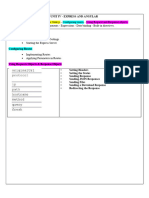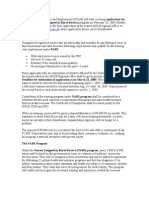▦ Generating a Base Server :-
• Setup a Readme.md File (Provides a Description/purpose, Installation
Instructions, Project Structure, Acknowledgements about your project.)
• Open Terminal & initialize your node package manager - 'npm init'
⇝ A 'package.json' file will be created in your Folder.
• Create a folder named - 'Backend'.
• Create entry level file (in Backend Folder) - 'index.js'
• Creating a '.env' file (A simple process that allows you to store environment
variables for your application. These variables can include sensitive information
like API keys or database credentials.)
⇝ Create a '.env' file in Directory.
⇝ In Terminal, type 'npm install dotenv', to install dotenv package.
⇝ In index.js (Backend Folder) - require('dotenv').config(); - to link .env &
index.js files.
⇝ Define Environment Variables: using the KEY=VALUE syntax.
⇝ Now, we can access our environment variables anywhere in your application
using - 'process.env.VARIABLE_NAME'
⇝ Add .env to .gitignore (This ensures that sensitive information stored in
the .env file isn't pushed to your repository.)
• Install Express Dependency (A piece of software that is required for another
piece of software to work correctly.) - 'npm install express'
• Creating our Backend Server:
⇝ Import Express in 'index.js' file.
⇝ Add - "type": "module" - in package.json file (to convert readability into
module format.)
⇝ Install nodemon DevDependency (Packages required only for the development
phase and not for the application to run in production.) using -
'npm install --save-dev nodemon'
⇝ Add - "dev": "nodemon backend/index.js" - to "scripts" (in package.json)
⇝ Create a Base/Home Route in 'index.js' file using app.get & app.listen.
⇝ Run it using Nodemon using - 'npm run dev'.
⇝ Check running of the file at localhost:3000.
▦ Defining Routes:
⇝ Check the working of server.
⇝ Type -
app.use(express.json())
app.use(express.urlencoded({extended: true}));
To simplify the data reaching at our servers. (i.e. We entered a plain
text which upon reaching to server converts to a mesh of many things, so to
simplify it for our server, we use this piece of code.)
⇝ Working up with '.ejs' file.
⇝ Install using 'npm i ejs'.
⇝ Set up ejs as a view engine.
app.set('view engine', 'ejs');
app.set('views', path.join('views'));
⇝ Set up a folder 'views'.
⇝ Setting up public static file (Setting up CSS, Vanilla JavaScript files).
⇝ Install path file using - 'npm i path'
⇝ Import path file using - import path from 'path'
⇝ Type -
app.use(express.static(path.join('public'))); - [Middleware]
⇝ Create a folder named 'public' at the root level.
⇝ Import css files to 'public' folder.
⇝ Run it on your server.
⇝ Base Routing :
� ⇝ Replace .send with .render.
⇝ We can use res.render to place value of a specific variable (Adding Dynamic
Content to .ejs file):-
⇝ res.render('fileName', {varName: varValue}) - [in index.js file]
⇝ <h1> Welcome to <%= varName %></h1>
⇝ Dynamic Routing :
⇝
⇝
⇝ Create a sub-folder 'Routes' (inside Backend), & create a file 'routes.js'
⇝ Export created routes from 'routes.js' & import it in 'index.js'.
▦ Adding Functionalities:
⇨ Handling Form Submissions :
⇝
⇝
⇝
⇝
⇝
⇨ Interacting with Databases :
⇝
⇨ Implementing Authentications/APIs:
⇝

































































































